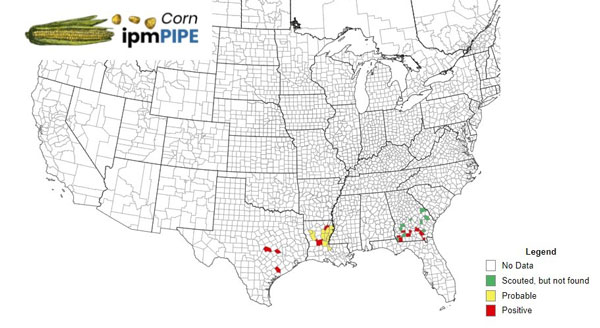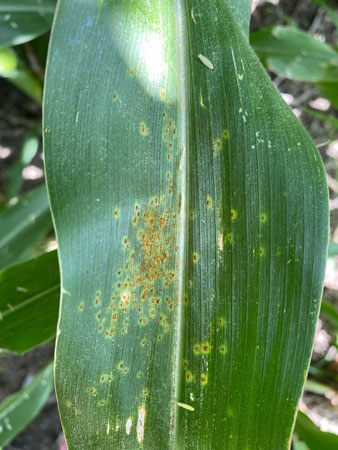Southern rust is now active on corn in Texas, Louisiana, and Georgia (Figure 1). Although this disease has not yet been reported in Kansas, it is time to start actively monitoring corn fields. The first positive fields in 2019 and 2020 were on July 11 and July 15, but based on the age of the pustules, the disease arrived sometime in mid-June. The severity is dependent on the weather. The 10-day forecast indicates that weather will remain favorable for disease development. Southern rust likes 90-degree days, warm nights, and high humidity.

Figure 1. Southern corn rust (Puccinia polyspora) has now been reported in Texas, Louisiana, and Georgia as of June 16, 2021. Source: https://corn.ipmpipe.org/southerncornrust/
Here are some frequently asked questions related to managing southern rust in Kansas:
Q1. Should I apply a fungicide prior to observing southern rust?
A1. It is not recommended to apply a fungicide to control southern rust unless disease has been observed in the canopy. Now that southern rust has been reported in the Texas, Louisiana, and Georgia, it is time to be out scouting corn fields. Once pustules are observed, the pathogen can reproduce rapidly if temperature and humidity are high.
Q2. What factors should I consider when making the decision to spray for southern rust?
A2. It is important to consider hybrid susceptibility, disease incidence (how many plants are affected), and the growth stage of the crop. Infection early in the season on a susceptible hybrid, coupled with conducive weather conditions, pose the highest risk for yield loss.
Q3. If I apply a foliar fungicide at tasseling (VT) or silking (R1) to control gray leaf spot, will this application have efficacy against southern rust?
A3. Yes. Most fungicides that are labeled for gray leaf spot are also effective for southern rust and will have residual activity for approximately three weeks after application, depending on the product. Fields should be carefully monitored for disease development. Research has suggested that applications can be effective at preserving yield up until dent (R5) when dealing with a susceptible hybrid and high disease pressure.
Q4. What fungicides are best to control southern rust?
A4. Efficacy ratings for corn fungicide management of southern rust have been compiled by a working group of corn researchers and can be found here:
Q5. How do I know if what I’m seeing is southern rust?
A5. Southern rust produces characteristic orange pustules of spores, primarily on the upper side of the leaf (Figure 2). If you run your finger across the pustules, the orange spores will be visible on your hand. The Kansas State Plant Diagnostic Lab can also confirm southern rust by observing spores under the microscope. Additional information about sending in a sample can be found here: https://www.plantpath.k-state.edu/extension/diagnostic-lab/.

Figure 2. Corn southern rust. Photo courtesy of Rodrigo Borba Onofre, K-State Plant Pathology.
For more information on identifying corn rusts, see K-State Research and Extension Bulletin MF3016, Corn Rust Identification and Management in Kansas.
Rodrigo Onofre, Plant Pathology
onofre@ksu.edu